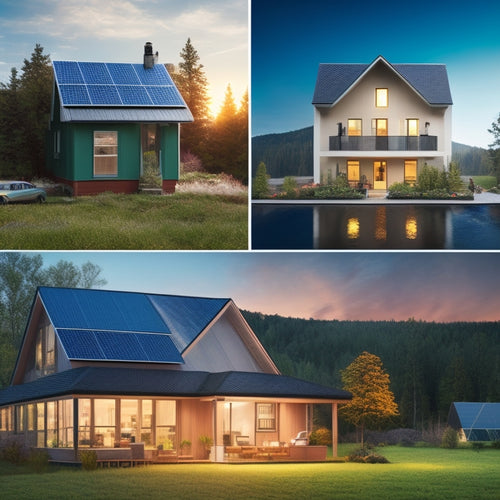Why Renewable Energy Matters for EV Charging
Share
You're making the switch to electric vehicles (EVs) to reduce your carbon footprint, but did you know that the energy source powering those EVs matters just as much? Renewable energy is key to minimizing your environmental impact. When you charge your EV with clean energy, you're reducing your reliance on fossil fuels and decreasing greenhouse gas emissions. Plus, local renewable energy projects can increase energy independence and reduce operating costs in the long run. As you dive deeper into the world of EV charging, you'll discover more ways to align your values with sustainable energy practices.
Key Takeaways
• Renewable energy for EV charging reduces carbon dependence and greenhouse gas emissions, contributing to a cleaner environment.
• Aligning energy policy with green infrastructure promotes sustainability and supports the growth of the Green Economy.
• Investing in renewable energy for EV charging stations reduces operational costs and increases property value through tax credits and incentives.
• Decentralizing energy production through community-based initiatives strengthens local energy independence and resilience.
• Integrating renewable energy sources into EV charging infrastructure ensures a reliable energy supply and supports a low-carbon economy.
Renewable Energy for EV Charging
To support your sustainable lifestyle, understanding the role of energy policy in promoting green infrastructure is crucial when switching to an electric vehicle (EV) and ensuring your charging habits align with your eco-friendly goals.
Governments can incentivize the adoption of renewable energy sources, such as solar or wind power, by implementing policies that encourage investment in green infrastructure. By doing so, you'll be able to charge your EV using clean energy, reducing your carbon dependence and supporting a cleaner environment.
Aligning energy policy with green infrastructure development will help you contribute to a more sustainable future.
Reducing Carbon Footprint Matters
You can greatly reduce your carbon footprint by switching to an electric vehicle (EV) and ensuring that your charging habits align with renewable energy sources.
As a conscious consumer, you're taking a significant step towards Climate Action. By choosing renewable energy for EV charging, you're reducing greenhouse gas emissions and contributing to a cleaner environment.
This move also supports the growth of the Green Economy, promoting sustainable development and a healthier planet.
Increasing Energy Independence Locally
By decentralizing energy production through community-based renewable energy initiatives, local energy independence is achievable, putting the power back in your hands. This shift enables communities to take control of their energy needs, reducing reliance on external providers. Community resilience is strengthened as energy decisions are made locally, rather than being dictated by distant authorities. Local governance plays an essential role in facilitating this change, ensuring that renewable energy projects align with community needs.
| Initiative | Benefits | Examples |
|---|---|---|
| Community Solar Programs | Reduces energy costs, promotes clean energy | Cooperative solar gardens, community-owned solar farms |
| Local Wind Cooperatives | Increases energy independence, creates jobs | Community-owned wind turbines, wind cooperatives |
| Municipal Renewable Energy Targets | Sets ambitious clean energy goals, drives innovation | City-wide renewable energy targets, green infrastructure investments |
| Energy Storage Cooperatives | Enhances energy resilience, reduces blackouts | Community-owned energy storage systems, microgrids |
| Green Infrastructure Investments | Fosters community engagement, promotes sustainable development | Green roofs, urban forestry initiatives, green spaces |
Lowering Operating Costs Long-Term
Optimizing EV charging infrastructure for long-term cost-effectiveness requires a strategic approach to reducing operational expenditures. You can achieve this by implementing cost savings strategies, such as time-of-use pricing and demand response programs. These strategies help you take advantage of lower electricity rates during off-peak hours, reducing your overall energy costs.
Additionally, you can benefit from financial incentives, like tax credits and rebates, offered by governments and utilities to encourage the adoption of renewable energy sources. By leveraging these incentives, you can further reduce your operating costs and maximize your return on investment.
Vehicle-to-Grid Technology Advantages
As you explore the benefits of Vehicle-to-Grid (V2G) technology, you'll discover several key advantages.
You'll find that V2G enables grid stabilization by providing a buffer against fluctuations in energy supply and demand.
Grid Stabilization Benefits
You can stabilize the grid by feeding excess energy back into it, thanks to Vehicle-to-Grid (V2G) technology that enables your electric vehicle to act as an energy storage device.
This technology allows you to regulate the grid's frequency and voltage, ensuring a stable power supply. With V2G, you can participate in frequency regulation, helping to balance the grid's supply and demand.
By injecting or absorbing power, you can maintain the grid's power quality, reducing the risk of blackouts and brownouts. By doing so, you're contributing to a more reliable and efficient energy system.
Bi-Directional Power Flow
Bi-directional power flow, a hallmark of Vehicle-to-Grid technology, empowers your electric vehicle to seamlessly exchange energy with the grid, providing a two-way flow of electricity that can greatly enhance the efficiency and resilience of the power distribution system.
This innovative technology enables your EV to act as an energy storage device, feeding excess energy back into the grid when not in use. By doing so, you'll be contributing to a smarter grid, where energy efficiency is optimized.
With bi-directional power flow, you'll have more control over your energy consumption and production, allowing you to make the most of your renewable energy sources.
This technology has the potential to revolutionize the way we think about energy distribution, making it more efficient, sustainable, and resilient.
Energy Storage Potential
With Vehicle-to-Grid technology, your electric vehicle's energy storage potential is harnessed, allowing you to tap into a vast reservoir of electricity that can be fed back into the grid when not in use. This stored energy can be leveraged to enhance grid resiliency and improve power quality.
Here are three ways V2G technology can benefit the grid:
-
Peak shaving: Reduce strain on the grid during peak hours by feeding excess energy back into the system.
-
Frequency regulation: Help stabilize grid frequency by injecting or absorbing energy as needed.
-
Renewable energy integration: Store excess energy generated by renewables and release it when needed, ensuring a more reliable and efficient energy supply.
Solar Panels for Commercial Use
Harnessing solar energy for commercial EV charging stations is becoming increasingly viable, as the cost of solar panels continues to decline. You're likely to contemplate solar panels for your commercial EV charging station, and for good reason. Not only do they reduce your reliance on the grid, but they also increase your energy independence.
Here's a breakdown of the benefits of solar panels for commercial use:
| Category | Benefit | Description |
|---|---|---|
| Energy Efficiency | Reduce energy costs | Solar panels generate free energy, reducing your energy bills. |
| Panel Maintenance | Low maintenance | Solar panels require minimal upkeep, saving you time and resources. |
| Environmental Impact | Reduce carbon footprint | Solar energy is a clean, renewable source of energy, reducing your carbon footprint. |
| Cost Savings | Increase property value | Installing solar panels can increase your property value. |
| Government Incentives | Tax benefits | You may be eligible for tax credits and incentives for installing solar panels. |
A Cleaner Transportation Future Ahead
As you explore the possibilities of a cleaner transportation future, you'll find that electric vehicles (EVs) play an essential role in reducing emissions.
By investing in EVs, you'll be contributing to a zero-emission transportation network that's more sustainable for the environment.
With the growth of sustainable energy infrastructure, you can expect to see a significant decrease in emissions, paving the way for a cleaner, healthier future.
Electric Vehicle Emissions Reduction
By shifting to electric vehicles (EVs), you can greatly lessen your carbon footprint, paving the way for a cleaner transportation future ahead. As you make the switch, you'll contribute to creating eco-friendly cities, where air quality is improved, and the greenhouse impact is reduced. Here are three key benefits of EV emission reduction:
-
Lower CO2 emissions: EVs produce much fewer emissions per mile compared to traditional gas-powered vehicles.
-
Improved air quality: With zero tailpipe emissions, EVs reduce air pollutants, creating a healthier environment for you and your community.
-
Reduced greenhouse gases: By choosing EVs, you'll help mitigate climate change by decreasing the amount of greenhouse gases released into the atmosphere.
Zero Emission Transportation Network
You're taking a significant step towards a cleaner transportation future by advocating for a zero-emission transportation network, where EVs can thrive and reach their full potential.
This network expansion is essential for widespread EV adoption, as it guarantees a seamless charging experience. Infrastructure development is key to supporting this growth, with a focus on high-power charging corridors and urban hubs.
As the network expands, you'll enjoy greater convenience, reduced range anxiety, and a significant decrease in emissions. With a zero-emission transportation network, you're not only reducing your carbon footprint but also contributing to a healthier environment.
Sustainable Energy Infrastructure Growth
How will the widespread adoption of EVs be supported by sustainable energy infrastructure growth, ensuring a cleaner transportation future ahead?
As you invest in green technologies, you're paving the way for a low-carbon economy. Sustainable energy infrastructure growth is essential to support the rising demand for EV charging.
Here are three key areas that require attention:
-
Grid modernization: Upgrade existing grid infrastructure to accommodate renewable energy sources and EV charging demands.
-
Green investments: Increase funding for renewable energy projects, such as wind and solar farms, to power EV charging stations.
-
Energy policy reforms: Encourage governments to develop and implement policies that promote the use of renewable energy and incentivize EV adoption.
Frequently Asked Questions
Can Renewable Energy Fully Power a Commercial EV Charging Station?
You can power a commercial EV charging station fully with renewable energy, but it depends on your energy storage capacity and grid capacity; with proper planning, you can guarantee a reliable and sustainable charging experience.
How Long Does It Take for Solar Panels to Pay for Themselves?
You conduct a payback analysis to determine how long solar panels take to pay for themselves, factoring in energy savings, which typically ranges from 5-10 years, depending on your energy usage and local incentives.
Are There Government Incentives for Renewable Energy in Transportation?
You're probably thinking, "Who needs incentives when saving the planet is reward enough?" But, fortunately, governments don't think that way, offering tax credits and policy frameworks to encourage renewable energy adoption in transportation.
Can EV Owners Sell Energy Back to the Grid With V2G Technology?
You can sell energy back to the grid with V2G technology, leveraging your EV as Energy Storage, and potentially earning credits through Smart Grid systems that optimize power distribution and consumption.
Will Renewable Energy Decrease the Overall Cost of EV Ownership?
You'll likely see a decrease in overall EV ownership cost as renewable energy increases fuel efficiency and carbon savings, reducing your reliance on fossil fuels and lowering your carbon footprint.
Related Posts
-

What Does Your Home Energy Audit Report Reveal?
Your home energy audit report reveals a detailed analysis of your energy consumption patterns, highlighting areas of ...
-

Gamify Your Home's Energy Generation and Savings
You're taking the next step in optimizing your home's energy generation and savings by utilizing the power of gamific...
-

10 Eco-Friendly Air Management Tools for Clean Home Living
You're taking an essential step towards creating a healthier living space by seeking eco-friendly air management tool...


